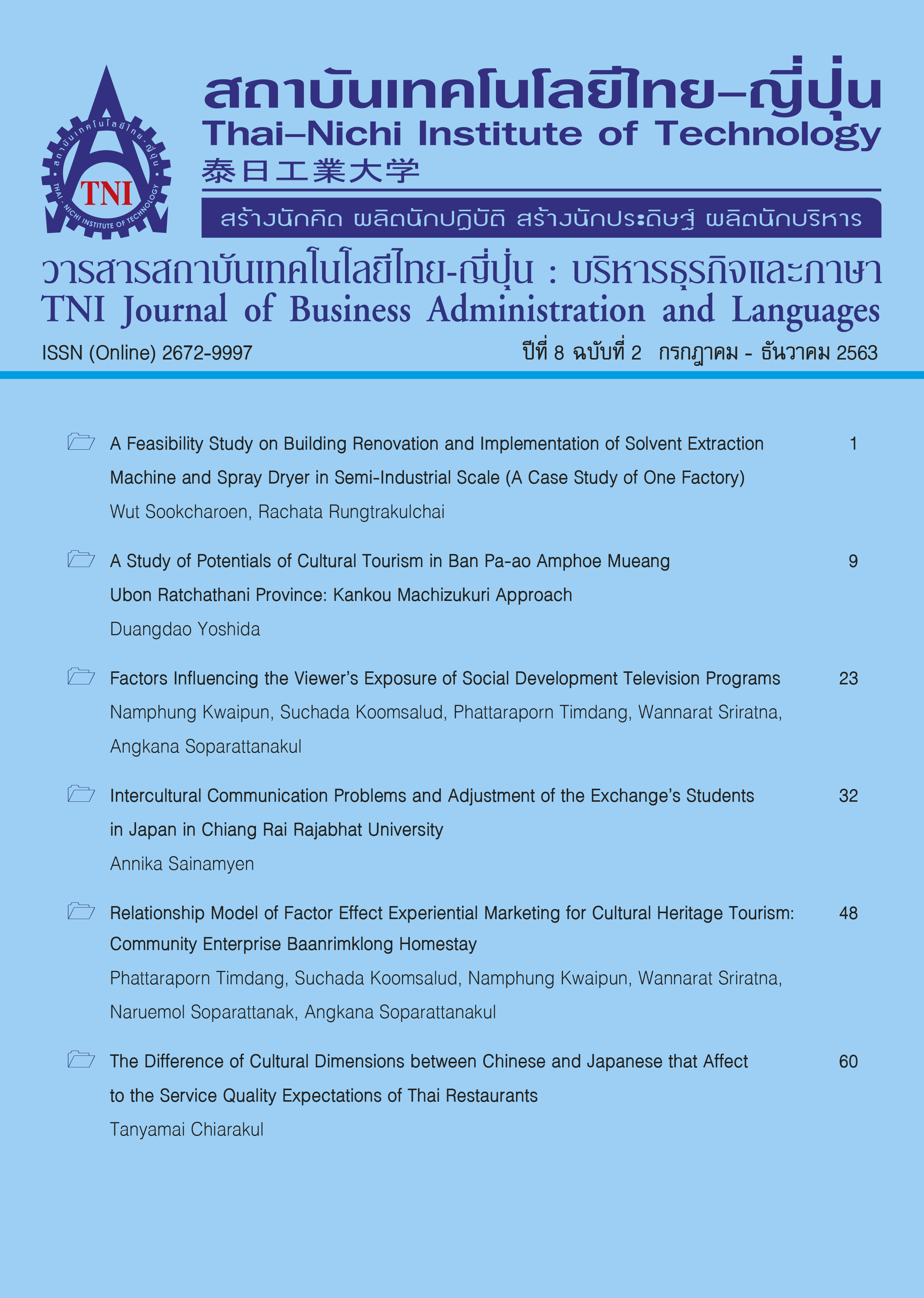Relationship Model of Factor Effect Experiential Marketing for Cultural Heritage Tourism: Community Enterprise Baanrimklong Homestay
Main Article Content
Abstract
This research aims to study the relationship model of factor effect experiential marketing for cultural heritage tourism in Baanrimklong homestay community enterprise in the term of studying: relationship model of factors affecting tourist’s experiential marketing for cultural heritage tourism in Baanrimklong homestay community enterprise. Data were collected from 400 tourists by questionnaires and analyzed by frequency distribution, percentage, arithmetic mean, standard deviation, skewness, kurtosis, and the Structural Equation Modeling techniques. The results revealed that the relationship model of factors affecting tourist’s experiential marketing for cultural heritage tourism in Baanrimklong homestay community enterprise from this research is consistent with empirical data, as well as good predictability and accepted at 73.4 percent. Causal relationship characteristics at 0.05 significance level showed that the lifestyle of tourists and motivation for travel in cultural heritage tourism had a causal relationship with tourist’s experiential marketing. Also, the lifestyle of tourists, motivation for travel in cultural heritage tourism, and experiential marketing of tourists have a causal relationship with experiential marketing achievement of cultural heritage tourism in Baanrimklong homestay community enterprise.
Article Details
Article Accepting Policy
The editorial board of Thai-Nichi Institute of Technology is pleased to receive articles from lecturers and experts in the fields of business administration, languages, engineering and technology written in Thai or English. The academic work submitted for publication must not be published in any other publication before and must not be under consideration of other journal submissions. Therefore, those interested in participating in the dissemination of work and knowledge can submit their article to the editorial board for further submission to the screening committee to consider publishing in the journal. The articles that can be published include solely research articles. Interested persons can prepare their articles by reviewing recommendations for article authors.
Copyright infringement is solely the responsibility of the author(s) of the article. Articles that have been published must be screened and reviewed for quality from qualified experts approved by the editorial board.
The text that appears within each article published in this research journal is a personal opinion of each author, nothing related to Thai-Nichi Institute of Technology, and other faculty members in the institution in any way. Responsibilities and accuracy for the content of each article are owned by each author. If there is any mistake, each author will be responsible for his/her own article(s).
The editorial board reserves the right not to bring any content, views or comments of articles in the Journal of Thai-Nichi Institute of Technology to publish before receiving permission from the authorized author(s) in writing. The published work is the copyright of the Journal of Thai-Nichi Institute of Technology.
References
Anderson, J. C., & Gerbing, D. W. (1988). Structural equation modeling in practice: A review and recommended two-step approach. Psychological Bulletin, 103(3), 411-423.
Antonides, G., & Raaij, W. F. (1998). Consumer behavior. A European perspective. Chichester: John Wiley & Sons.
Assael, H. (1998). Consumer behavior and marketing action (6th ed.). United States of America: South-western College Publishing.
Balter, D., & Butman, J. (2005). Grapevine: The new art of word-of-mouth marketing. New York: Portfolio.
Bourdeau, L. B. (2005). A new examination of service loyalty: Identification of the antecedents and outcomes of additional loyalty framework. (Doctoral dissertation). Florida University, Florida.
Carbone, E. (2004). The effect of unemployment on consumption: an experimental analysis. The Economic Journal, 114(497), 660-683.
Cronbach, L. J. (1990). How to judge tests: Reliability and other qualities, Essentials of psychological testing. New York: Collins.
Cronin, J. J., Brady, M. K., & Hult, G. T. M. (2000). Assessing the effects of quality, value, and customer satisfaction on consumer behavioral intentions in service environments. Journal of Retailing, 76(2), 193-218.
Division of Sports and Tourism Economy. (2019). Tourism statistics. (in Thai). Retrieved from https://www.mots.go.th/more_news_new.php?cid=525
Engel, J. F., Blackwell, R. D., & Miniard, P. W. (1993). Consumer behavior. Fort Worth,TX: The Dryden.
Gentile, C., N. Spiller, & G. Noci. (2007). How to sustain the customer experience: An overview of experience components that co-create value with the customer. European Management Journal, 25(5), 395–410.
Hair, J. A.,Tatham, T. R., & Black, W. (1998). Multivariate data analysis. New York: Prentice Hall.
Hair, O.F., A. Money, P. Samuel & M. Page. (2007). Research methods for business. Chichester: John Wiley & Sons.
Hellier, P. K., Ganesan, G. M., Carr, R. A., & Rickard, G. A. (2003). Customer repurchase intention: A general structural equation model. European Journal of Marketing, 37(11-12), 1762-1800.
Hudman, L.E. (1980). Tourism: A shining world. Ohio: Rid lnc.
Kline, P. (1994). An easy guide to factor analysis. London & New York: Routledge.
Kotler, P., & Keller, K. L. (2009). Marketing management (13th ed.). New Jersey: Prentice Hall.
Ozturk, A.B., & Qu, H. (2008). The impact of destination images on tourists' perceived value, expectations, and loyalty. Journal of Quality Assurance in Hospitality & Tourism, 9(4), 275-297.
Prahalad, C. K., & Ramaswamy, V. (2004). The future of competition: Co-creating unique value with customers. Boston: Harvard Business Review Press.
Pizam, A., & Mansfield, Y. (1999). Consumer behavior in travel and tourism. New York: Haworth Press.
Pizam, A., Neumann, Y., & Reichel, A. (1979). Tourist satisfaction: Uses and misuses. Annals of Tourism Research, 6(2), 195-197.
Sharpley, Richard. (2006). Travel and tourism. London: Sage Publications.
Reisinger, Y. (2001). Unique characteristics of tourism, hospitality, and leisure services. New York: The Haworth Hospitality Press.
Tse, D.K. & Wilton, P.C. (1988). Model of customer satisfaction formation: An Extension. Journal of Marketing Research, 25(2), 204-212.
Vargo, S.L. & Lusch, R.F. (2004). Evolving to a new dominant logic for marketing. Journal of Marketing, 68(1), 1-17.


